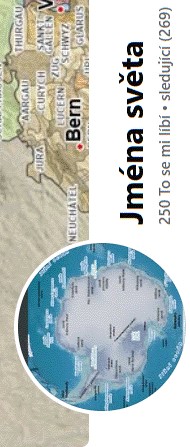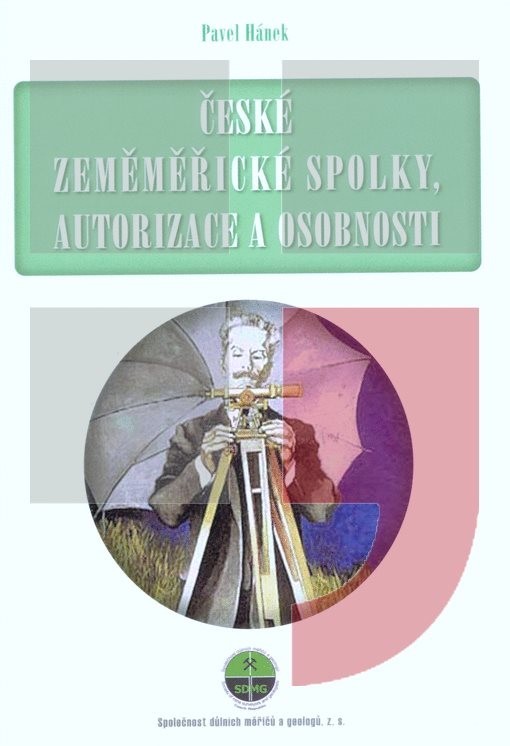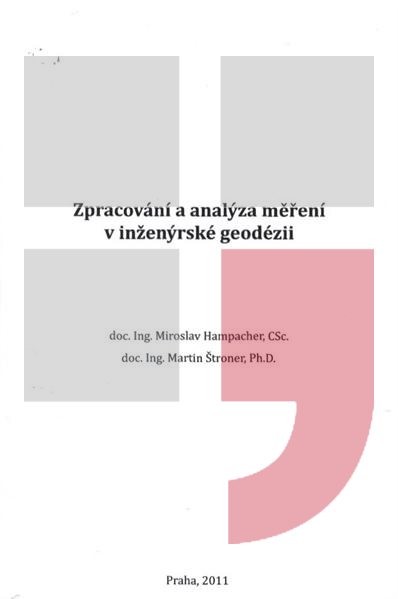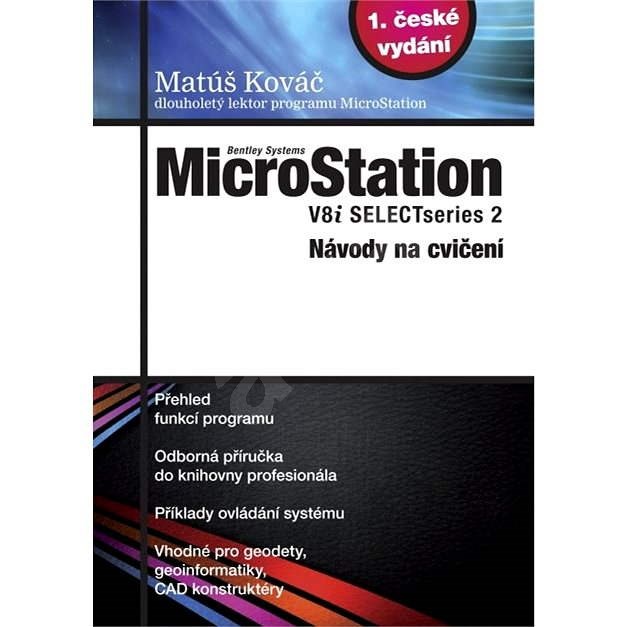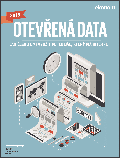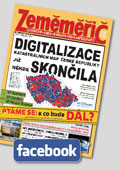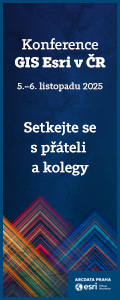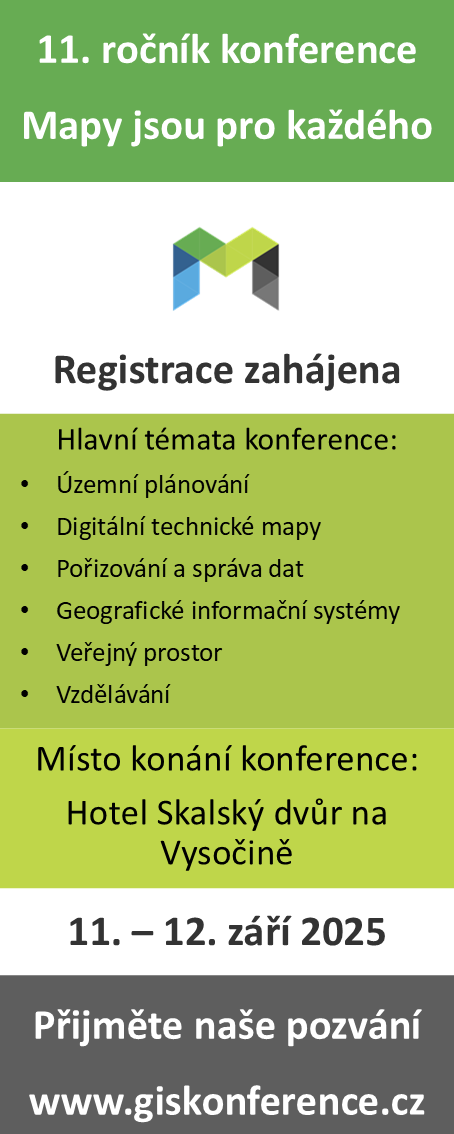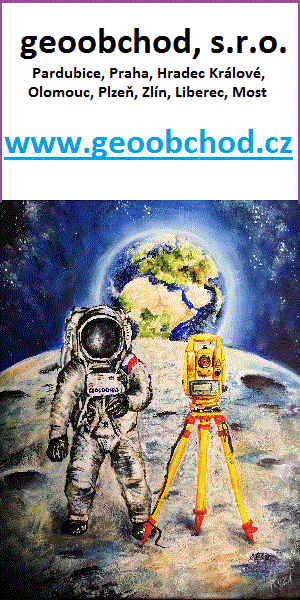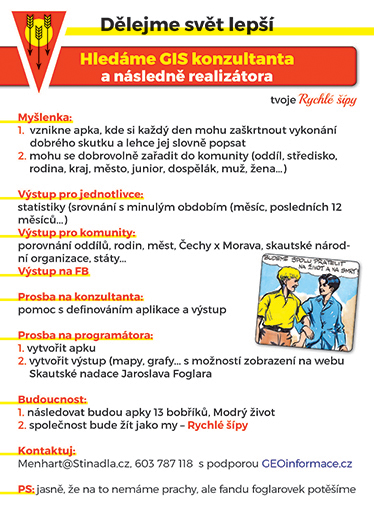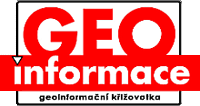zprávy
zdroje zpráv:Konference Telč 2015, listopad 2015
5.10.2015 11:10 Zeměměřič 15. ročník konference zabývající se problematikou fotogrammetrie, dálkového průzkumu Země, laserového skenování a GIS proběhne 9. - 11.11.2015 v Telči.Time-lapse countdown
5.10.2015 10:38 ESA Navigation
This new time-lapse video portrays the hard, intricate work that went into the last Galileo launch
Time-lapse countdown
5.10.2015 10:38 ESA Navigation
This time-lapse video portrays the hard, intricate work that went into Europe's last Galileo launch
Pátá mise rakety Ariane 5 v letošním roce
5.10.2015 8:45 Český Kosmický PortálTřicátého září večer dopravila nosná raketa Ariane 5 na plánovanou oběžnou dráhu dvojici telekomunikačních družic. Stalo se tak po startu z evropského kosmodromu v Kourou (stát Francouzská Guayana).
Pátá mise rakety Ariane 5 v letošním roce
5.10.2015 8:45 Český Kosmický PortálTřicátého září večer dopravila nosná raketa Ariane 5 na plánovanou oběžnou dráhu dvojici telekomunikačních družic. Stalo se tak po startu z evropského kosmodromu v Kourou (stát Francouzská Guayana).
Odlehčený rozhovor o dronech s Jakubem v pořadu "Na gauči" na G.cz
5.10.2015 8:02 UpVision Odlehčený rozhovor o dronech s Jakubem v pořadu "Na gauči" na G.cz, jako video nebo jen audio, zde:http://g.cz/rozhovor-na-gauci-dil-5-host-vysoko-nad-ceskem-letajici-jakub-karas
Potenciální přirozená vegetace
5.10.2015 2:00 Cenia - Katalog metadat ČR - INSPIRE Tato služba zobrazuje mapu potenciální přirozené vegetace České republiky, ta je výrazem rovnováhy mezi současným člověkem nevratně změněným prostředím a vegetací. Byla sestavena na základě syntézy terénního výzkumu a vyhodnocení všech publikovaných fytocenologických a ekologických dat a dřívějších mapových podkladů. Legendu mapy tvoří 51 mapovacích vegetačních jednotek převážně úrovně asociací, příp. jejich skupin.Společnost VARS BRNO představila CleveRA Car v Jihlavě!
5.10.2015 2:00 VARS.czDalší zastávkou předváděcí roadshow nového diagnostického vozidla CleveRA Car byla Jihlava!
EnviSec - Klasifikace snímků z povodňových situací
5.10.2015 2:00 Cenia - Katalog metadat ČR - INSPIRE Klasifikace snímků z povodňových situací na základě analýzy dat z družic Landsat. Pro vyhodnocení snímků byl použit postup uvedený v publikaci "Možnosti využití metod dálkového průzkumu a prostorových analýz pro řešení krizových situací" ISBN 978-80-85087-22-2, která je jedním z výstupů CENIA v rámci projektu EnviSec "Integrované hodnovení dopadů globálních změn na environmentální bezpečnost České republiky" (VG20122015091).EnviSec - Povodňové riziko
5.10.2015 2:00 Cenia - Katalog metadat ČR - INSPIRE Vrstva povodňových rizik byla vytvořena jako jeden ze základních vstupů pro analýzu environmenátlních rizik v rámci projektu EnviSec "Integrované hodnovení dopadů globálních změn na environmentální bezpečnost České republiky" (VG20122015091). Podkladem pro zpracování dat byla záplavová území z databáze DIBAVOD, která byla převedena do gridu 1 x 1 km.A118 - Jiné záměry - ÚAP 2014
5.10.2015 2:00 Cenia - Katalog metadat ČR - INSPIRE A118 - Informace o jevu Jiné záměry ve správním obvodu ORP Moravské Budějovice dle zákona č.183/2006 Sb.A116 - Počet dokončených bytů k 31.12. každého roku - ÚAP 2014
5.10.2015 2:00 Cenia - Katalog metadat ČR - INSPIRE A116 - Informace o jevu Počet dokončených bytů k 31.12. každého roku ve správním obvodu ORP Moravské Budějovice dle zákona č.183/2006 Sb.Společnost VARS BRNO představila CleveRA Car v Jihlavě!
5.10.2015 2:00 VARS.czDalší zastávkou předváděcí roadshow nového diagnostického vozidla CleveRA Car byla Jihlava!
Pozvánka na 4. ročník česko-slovenskej konferencie Inspirujme se...
4.10.2015 23:23 GEOINFORMATIKA.skČGS – Blok expertů MRS 7. 10. 2015
2.10.2015 14:45 Katedra geografie UP Olomouc Zveme Vás na přednášku v rámci Bloku expertů MRSPrevence ozbrojeného konfliktu na Šalomounových ostrovech
která se uskuteční ve středu 7. října 2015 od 15.00 do 16.30 na učebně LP 5007 Přírodovědecké fakulty UP. Přednáší Ladislav Koubek (pozvánka).
Berlin celebration
2.10.2015 10:05 ESA Observing the Earth
Earth observation image of the week: a Sentinel-2A false colour image of Berlin in Germany, also featured on the Earth from Space video programme
Berlin celebration
2.10.2015 10:05 ESA Observing the Earth
Earth observation image of the week: a Sentinel-2A false colour image of Berlin in Germany, also featured on the Earth from Space video programme
Informace o projektech spolufinancovaných EU na Mapovém serveru CRR
2.10.2015 9:54 T-MAPY V mobilních aplikacích Mapového serveru Centra pro regionální rozvoj ČR přibyla další sada dat – Projekty EU. Zájemci zde naleznou informace o projektech spolufinancovaných z peněz EU pro vybranou obec nebo městskou část. Aplikaci pro desktopové prohlížeče naleznete zde.nákladní automobil KlA PREGlO TB-25 (1)
2.10.2015 9:49 ČÚZK - předpisy a opatření /Urady/Katastralni-urady/Katastralni-urady/Katastralni-urad-pro-Kralovehradecky-kraj/Nabidky-majetku/nakladni-automobil-KlA-PREGlO-TB-25-(1)nákladní automobil KlA PREGlO TB-25 (1)
2.10.2015 9:49 ČÚZK /Urady/Katastralni-urady/Katastralni-urady/Katastralni-urad-pro-Kralovehradecky-kraj/Nabidky-majetku/nakladni-automobil-KlA-PREGlO-TB-25-(1)Nabídka majetku pro OSS
2.10.2015 8:59 ČÚZK /Urady/Zememericky-urad/Nabidka-majetku/Nabidka-majetku-pro-OSSNabídka majetku pro OSS
2.10.2015 8:59 Zeměměřický úřad /Urady/Zememericky-urad/Nabidka-majetku/Nabidka-majetku-pro-OSSNabídka majetku pro OSS
2.10.2015 8:59 ČÚZK - předpisy a opatření /Urady/Zememericky-urad/Nabidka-majetku/Nabidka-majetku-pro-OSSDen otevřených dveří v ESTEC je plný
2.10.2015 8:43 Český Kosmický PortálAkce, která se bude konat v neděli 4. října „den otevřených dveří ve středisku ESTEC“, je plně obsazena. ESA přijala již dvanáct tisíc rezervací. Každý, kdo plánuje účast - včetně dětí - musí mít vlastní registraci.
Den otevřených dveří v ESTEC je plný
2.10.2015 8:43 Český Kosmický PortálAkce, která se bude konat v neděli 4. října „den otevřených dveří ve středisku ESTEC“, je plně obsazena. ESA přijala již dvanáct tisíc rezervací. Každý, kdo plánuje účast - včetně dětí - musí mít vlastní registraci.
GISHackathon (pozvánka)
2.10.2015 8:42 GISportal.cz 20. a 21. listopadu proběhne již třetí ročník úspěčné akce GISHackathon, o loňském ročníku jsme psali například zde. GISHackathon proběhne v prostorách Mendelovy univerzity v Brně a bude obsahovat přednášky a workshopy pro ty, kteří ...Atlas Praha 5000
2.10.2015 2:03 Geoportál PrahaNová aplikace Atlas Praha 5000 prezentuje podrobná data z průzkumu současného stavu využití území a technické infrastruktury.
A115 - Ostatní veřejná infrastruktura - ÚAP 2014
2.10.2015 2:00 Cenia - Katalog metadat ČR - INSPIRE A115 - Informace o jevu Ostatní veřejná infrastruktura ve správním obvodu ORP Moravské Budějovice dle zákona č.183/2006 Sb.A114 - Jiná OP - ÚAP 2014
2.10.2015 2:00 Cenia - Katalog metadat ČR - INSPIRE A114 - Informace o jevu Jiná OP ve správním obvodu ORP Moravské Budějovice dle zákona č.183/2006 Sb.A111 - Objekt požární ochrany - ÚAP 2014
2.10.2015 2:00 Cenia - Katalog metadat ČR - INSPIRE A111 - Informace o jevu Objekt požární ochrany ve správním obvodu ORP Moravské Budějovice dle zákona č.183/2006 Sb.A110 - Objekt civilní ochrany - ÚAP 2014
2.10.2015 2:00 Cenia - Katalog metadat ČR - INSPIRE A110 - Informace o jevu Objekt civilní ochrany ve správním obvodu ORP Moravské Budějovice dle zákona č.183/2006 Sb.A082 - Komunikační vedení včetně OP - ÚAP 2014
2.10.2015 2:00 Cenia - Katalog metadat ČR - INSPIRE A082 - Informace o jevu Komunikační vedení včetně OP ve správním obvodu ORP Moravské Budějovice dle zákona č.183/2006 Sb.A106 - Cyklostezka, cyklotrasa, hipostezka a turistická stezka - ÚAP 2014
2.10.2015 2:00 Cenia - Katalog metadat ČR - INSPIRE A106 - Informace o jevu Cyklostezka, cyklotrasa, hipostezka a turistická stezka ve správním obvodu ORP Moravské Budějovice dle zákona č.183/2006 Sb.A093 - Místní a účelové komunikace - ÚAP 2014
2.10.2015 2:00 Cenia - Katalog metadat ČR - INSPIRE A093 - Informace o jevu Místní a účelové komunikace ve správním obvodu ORP Moravské Budějovice dle zákona č.183/2006 Sb.A095 - Železniční dráha regionální včetně OP - ÚAP 2014
2.10.2015 2:00 Cenia - Katalog metadat ČR - INSPIRE A095 - Informace o jevu Železniční dráha regionální včetně OP ve správním obvodu ORP Moravské Budějovice dle zákona č.183/2006 Sb.A103 - Letecká stavba včetně OP - ÚAP 2014
2.10.2015 2:00 Cenia - Katalog metadat ČR - INSPIRE A103 - Informace o jevu Letecká stavba včetně OP ve správním obvodu ORP Moravské Budějovice dle zákona č.183/2006 Sb.A109 - Vymezené zóny havarijního plánování - ÚAP 2014
2.10.2015 2:00 Cenia - Katalog metadat ČR - INSPIRE A109 - Informace o jevu Vymezené zóny havarijního plánování ve správním obvodu ORP Moravské Budějovice dle zákona č.183/2006 Sb.A090 - Silnice I. třídy včetně OP - ÚAP 2014
2.10.2015 2:00 Cenia - Katalog metadat ČR - INSPIRE A090 - Informace o jevu Silnice I. třídy včetně OP ve správním obvodu ORP Moravské Budějovice dle zákona č.183/2006 Sb.A102 - Letiště včetně OP - ÚAP 2014
2.10.2015 2:00 Cenia - Katalog metadat ČR - INSPIRE A102 - Informace o jevu Letiště včetně OP ve správním obvodu ORP Moravské Budějovice dle zákona č.183/2006 Sb.A081 - Elektronické komunikační zařízení včetně OP - ÚAP 2014
2.10.2015 2:00 Cenia - Katalog metadat ČR - INSPIRE A081 - Informace o jevu Elektronické komunikační zařízení včetně OP ve správním obvodu ORP Moravské Budějovice dle zákona č.183/2006 Sb.A091 - Silnice II. třídy včetně OP, A092 - Silnice III. třídy včetně OP - ÚAP 2014
2.10.2015 2:00 Cenia - Katalog metadat ČR - INSPIRE A091 - Informace o jevu Silnice II. třídy včetně OP ve správním obvodu ORP Moravské Budějovice dle zákona č.183/2006 Sb.A092 - Informace o jevu Silnice III. třídy včetně OP ve správním obvodu ORP Moravské Budějovice dle zákona č.183/2006 Sb.A113 - OP hřbitova, krematoria - ÚAP 2014
2.10.2015 2:00 Cenia - Katalog metadat ČR - INSPIRE A113 - Informace o jevu OP hřbitova, krematoria ve správním obvodu ORP Moravské Budějovice dle zákona č.183/2006 Sb.A112 - Objekt důležitý pro plnění úkolů Policie ČR - ÚAP 2014
2.10.2015 2:00 Cenia - Katalog metadat ČR - INSPIRE A112 - Informace o jevu Objekt důležitý pro plnění úkolů Policie ČR ve správním obvodu ORP Moravské Budějovice dle zákona č.183/2006 Sb.A117 - Zastavitelná plocha - ÚAP 2014
2.10.2015 2:00 Cenia - Katalog metadat ČR - INSPIRE A117 - Informace o jevu Zastavitelná plocha ve správním obvodu ORP Moravské Budějovice dle zákona č.183/2006 Sb.Vyhlášení platnosti (3)
1.10.2015 14:29 ČÚZK /Urady/Katastralni-urady/Katastralni-urady/Katastralni-urad-pro-Jihomoravsky-kraj/Katastralni-pracoviste/KP-Znojmo/O-uradu/Aktuality/Vyhlaseni-platnosti-(3)Vyhlášení platnosti (3)
1.10.2015 14:29 ČÚZK - předpisy a opatření Vyhlášení platnosti obnoveného katastrálního operátu v k.ú. Suchohrdly u ZnojmaVyhlášení platnosti (3)
1.10.2015 14:29 ČÚZK - předpisy a opatření /Urady/Katastralni-urady/Katastralni-urady/Katastralni-urad-pro-Jihomoravsky-kraj/Katastralni-pracoviste/KP-Znojmo/O-uradu/Aktuality/Vyhlaseni-platnosti-(3)Earth from Space
1.10.2015 14:00 ESA Observing the Earth
Join us Friday, 2 October, at 10:00 CEST for the ‘Earth from Space’ video programme. This week features a Sentinel-2A image of the city of Berlin, in Germany
zmeny_VUC_2016
1.10.2015 11:24 ČÚZK - předpisy a opatření /Uvod/Produkty-a-sluzby/RUIAN/2-Poskytovani-udaju-RUIAN-ISUI-VDP/Informace-o-uzemni-identifikaci-(1)/Informace-o-uzemni-identifikaci/zmeny_VUC_2016Pořízení leteckých senzorů pro informační systém zeměměřictví a Geoportál ČÚZK
1.10.2015 9:56 ČÚZK - předpisy a opatření /Urady/Zememericky-urad/Dalsi-informace/Porizeni-leteckych-senzoru-pro-informacni-system-z/Porizeni-leteckych-senzoru-pro-informacni-system-zCall for Media
1.10.2015 9:16 ESA Observing the Earth
Media representatives are invited to an event for the signing of the Cooperation Agreement between ESA and Eumetsat on the MetOp Second Generation series of meteorological satellites
CubeSaty ESA budou vypuštěny v pondělí
1.10.2015 8:42 Český Kosmický PortálDánská zástava zavlaje opravdu velmi vysoko již v pondělí 5. října poté, co dvě malé družice navržené a postavené právě v Dánsku, budou uvolněny na samostatnou cestu z Mezinárodní kosmické stanice. Půjde o studentský satelit AAUSay-5 a profesionální technologický demonstrátor GomX-3.
CubeSaty ESA budou vypuštěny v pondělí
1.10.2015 8:42 Český Kosmický PortálDánská zástava zavlaje opravdu velmi vysoko již v pondělí 5. října poté, co dvě malé družice navržené a postavené právě v Dánsku, budou uvolněny na samostatnou cestu z Mezinárodní kosmické stanice. Půjde o studentský satelit AAUSay-5 a profesionální technologický demonstrátor GomX-3.
Nová učebnica: Python pre Geovedné aplikácie
1.10.2015 8:21 GISportal.cz Autorský tím: Libor Burian z Katedry Fyzickej geografie a geoekológie a Hana Stanková z Katedry kartografie, geoinformatiky a DPZ Univerzity Komenského v Bratislave vydávajú učebnicu Python pre Geovedné aplikácie. Učebnica vychádza v slovenčine, v elektronickej ...A041 - Bonitovaná půdně ekologická jednotka – BPEJ - ÚAP 2014
1.10.2015 2:00 Cenia - Katalog metadat ČR - INSPIRE A041 - Informace o jevu Bonitovaná půdně ekologická jednotka – BPEJ ve správním obvodu ORP Moravské Budějovice dle zákona č.183/2006 Sb.A061 - Poddolované území - ÚAP 2014
1.10.2015 2:00 Cenia - Katalog metadat ČR - INSPIRE A061 - Informace o jevu Poddolované území ve správním obvodu ORP Moravské Budějovice dle zákona č.183/2006 Sb.A027 - Národní přírodní rezervace, A028 - Přírodní rezervace, A029 - Národní přírodní památka, A031 - Přírodní památka - všechny jevy včetně OP - ÚAP 2014
1.10.2015 2:00 Cenia - Katalog metadat ČR - INSPIRE A027 - Informace o jevu Národní přírodní rezervace včetně OP ve správním obvodu ORP Moravské Budějovice dle zákona č.183/2006 Sb. - nevyskytuje seA028 - Informace o jevu Přírodní rezervace včetně OP ve správním obvodu ORP Moravské Budějovice dle zákona č.183/2006 Sb. A029 - Informace o jevu Národní přírodní památka včetně OP ve správním obvodu ORP Moravské Budějovice dle zákona č.183/2006 Sb. - nevyskytuje seA031 - Informace o jevu přírodní památka včetně OP ve správním obvodu ORP Moravské Budějovice dle zákona č.183/2006 Sb.A073 - Nadzemní a podzemní vedení elektrizační soustavy včetně OP - ÚAP 2014
1.10.2015 2:00 Cenia - Katalog metadat ČR - INSPIRE A073 - Informace o jevu Nadzemní a podzemní vedení elektrizační soustavy včetně OP ve správním obvodu ORP Moravské Budějovice dle zákona č.183/2006 Sb.A043 - Investice do půdy za účelem zlepšení půdní úrodnosti - ÚAP 2014
1.10.2015 2:00 Cenia - Katalog metadat ČR - INSPIRE A043 - Informace o jevu Investice do půdy za účelem zlepšení půdní úrodnosti ve správním obvodu ORP Moravské Budějovice dle zákona č.183/2006 Sb.A034 - NATURA 2000 – evropsky významná lokalita - ÚAP 2014
1.10.2015 2:00 Cenia - Katalog metadat ČR - INSPIRE A034 - Informace o jevu NATURA 2000 – evropsky významná lokalita ve správním obvodu ORP Moravské Budějovice dle zákona č.183/2006 Sb.A019 - Místo významné události - ÚAP 2014
1.10.2015 2:00 Cenia - Katalog metadat ČR - INSPIRE A019 - Informace o jevu Místo významné události ve správním obvodu ORP Moravské Budějovice dle zákona č.183/2006 Sb.A050 - Záplavové území , A051 - Aktivní zóna záplavového území - ÚAP 2014
1.10.2015 2:00 Cenia - Katalog metadat ČR - INSPIRE A050 - Informace o jevu Záplavové území ve správním obvodu ORP Moravské Budějovice dle zákona č.183/2006 Sb.A051 - Informace o jevu Záplavové území ve správním obvodu ORP Moravské Budějovice dle zákona č.183/2006 Sb.A068 - Vodovodní síť včetně OP - ÚAP 2014
1.10.2015 2:00 Cenia - Katalog metadat ČR - INSPIRE A068 - Informace o jevu Vodovodní síť včetně OP ve správním obvodu ORP Moravské Budějovice dle zákona č.183/2006 Sb.A037 - Lesy ochranné, A038 - Les zvláštního určení - A039 - Lesy hospodářské - ÚAP 2014
1.10.2015 2:00 Cenia - Katalog metadat ČR - INSPIRE A037 - Informace o jevu Lesy ochranné ve správním obvodu ORP Moravské Budějovice dle zákona č.183/2006 Sb.A038 - Informace o jevu Les zvláštního určení ve správním obvodu ORP Moravské Budějovice dle zákona č.183/2006 Sb.A039 - Informace o jevu Lesy hospodářské ve správním obvodu ORP Moravské Budějovice dle zákona č.183/2006 Sb.A044 - Vodní zdroj povrchové, podzemní vody včetně OP - ÚAP 2014
1.10.2015 2:00 Cenia - Katalog metadat ČR - INSPIRE A044 - Informace o jevu Vodní zdroj povrchové, podzemní vody včetně OP ve správním obvodu ORP Moravské Budějovice dle zákona č.183/2006 Sb.A022 - Významný krajinný prvek registrovaný - ÚAP 2014
1.10.2015 2:00 Cenia - Katalog metadat ČR - INSPIRE A022 - Informace o jevu Významný krajinný prvek registrovaný ve správním obvodu ORP Moravské Budějovice dle zákona č.183/2006 Sb.A069 - Technologický objekt odvádění a čištění odpadních vod včetně OP - ÚAP 2014
1.10.2015 2:00 Cenia - Katalog metadat ČR - INSPIRE A069 - Informace o jevu Technologický objekt odvádění a čištění odpadních vod včetně OP ve správním obvodu ORP Moravské Budějovice dle zákona č.183/2006 Sb.A042 - Hranice biochor - ÚAP 2014
1.10.2015 2:00 Cenia - Katalog metadat ČR - INSPIRE A042 - Informace o jevu Hranice biochor ve správním obvodu ORP Moravské Budějovice dle zákona č.183/2006 Sb.A062 - Sesuvné území a území jiných geologických rizik - ÚAP 2014
1.10.2015 2:00 Cenia - Katalog metadat ČR - INSPIRE A062 - Informace o jevu Sesuvné území a území jiných geologických rizik ve správním obvodu ORP Moravské Budějovice dle zákona č.183/2006 Sb.A046 - Zranitelná oblast - ÚAP 2014
1.10.2015 2:00 Cenia - Katalog metadat ČR - INSPIRE A046 - Informace o jevu Zranitelná oblast ve správním obvodu ORP Moravské Budějovice dle zákona č.183/2006 Sb.A075 - Vedení plynovodu včetně OP a bezpečnostního pásma - ÚAP 2014
1.10.2015 2:00 Cenia - Katalog metadat ČR - INSPIRE A075 - Informace o jevu Vedení plynovodu včetně OP a bezpečnostního pásma ve správním obvodu ORP Moravské Budějovice dle zákona č.183/2006 Sb.A017- 018 - Oblast a místo krajinného rázu a jejich charakteristika - ÚAP 2014
1.10.2015 2:00 Cenia - Katalog metadat ČR - INSPIRE A017 - Informace o jevu Oblast krajinného rázu a jeho charakteristika ve správním obvodu ORP Moravské Budějovice dle zákona č.183/2006 Sb.A018 - Informace o jevu Místo krajinného rázu a jeho charakteristika ve správním obvodu ORP Moravské Budějovice dle zákona č.183/2006 Sb.A063 - Staré důlní dílo - ÚAP 2014
1.10.2015 2:00 Cenia - Katalog metadat ČR - INSPIRE A063 - Informace o jevu Staré důlní dílo ve správním obvodu ORP Moravské Budějovice dle zákona č.183/2006 Sb.A036 - Lokality výstupu zvláště chráněných druhů rostlin a živočichů s národním významem - ÚAP 2014
1.10.2015 2:00 Cenia - Katalog metadat ČR - INSPIRE A036 - Informace o jevu Lokality výstupu zvláště chráněných druhů rostlin a živočichů s národním význam ve správním obvodu ORP Moravské Budějovice dle zákona č.183/2006 Sb.A023 - Významný krajinný prvek ze zákona- ÚAP 2014
1.10.2015 2:00 Cenia - Katalog metadat ČR - INSPIRE A022 - Informace o jevu Významný krajinný prvek ze zákona ve správním obvodu ORP Moravské Budějovice dle zákona č.183/2006 Sb.A057 - Dobývací prostor - ÚAP 2014
1.10.2015 2:00 Cenia - Katalog metadat ČR - INSPIRE A057 - Informace o jevu Dobývací prostor ve správním obvodu ORP Moravské Budějovice dle zákona č.183/2006 Sb.A040 - Vzdálenost 50 m od okraje lesa - ÚAP 2014
1.10.2015 2:00 Cenia - Katalog metadat ČR - INSPIRE A040 - Informace o jevu Vzdálenost 50 m od okraje lesa ve správním obvodu ORP Moravské Budějovice dle zákona č.183/2006 Sb.A013-15 - Historicky významná stavba, architektonicky cenná stavba, významná stavební dominanta - ÚAP 2014
1.10.2015 2:00 Cenia - Katalog metadat ČR - INSPIRE A013 - Informace o jevu Historicky významná stavba ve správním obvodu ORP Moravské Budějovice dle zákona č.183/2006 Sb.A014 - Informace o jevu Architektonicky cenná stavba ve správním obvodu ORP Moravské Budějovice dle zákona č.183/2006 Sb.A015 - Informace o jevu Významná stavební dominanta ve správním obvodu ORP Moravské Budějovice dle zákona č.183/2006 Sb.A070 - Síť kanalizačních stok včetně OP - ÚAP 2014
1.10.2015 2:00 Cenia - Katalog metadat ČR - INSPIRE A070 - Informace o jevu Síť kanalizačních stok včetně OP ve správním obvodu ORP Moravské Budějovice dle zákona č.183/2006 Sb.Přírodní parky
1.10.2015 2:00 Cenia - Katalog metadat ČR - INSPIRE Přírodní parky vyhlašují a vymezují jednotlivé krajské úřady na základě zákona č. 114/1992 Sb. o ochraně přírody a krajiny. Data jsou platná pro stav v roce 2006.A065 - Oblast se zhoršenou kvalitou ovzduší - ÚAP 2014
1.10.2015 2:00 Cenia - Katalog metadat ČR - INSPIRE A065 - Informace o jevu Oblast se zhoršenou kvalitou ovzduší ve správním obvodu ORP Moravské Budějovice dle zákona č.183/2006 Sb.A048 -Vodní nádrž - ÚAP 2014
1.10.2015 2:00 Cenia - Katalog metadat ČR - INSPIRE A048 - Informace o jevu Vodní nádrž ve správním obvodu ORP Moravské Budějovice dle zákona č.183/2006 Sb.A067 - Technologický objekt zásobování vodou včetně OP - ÚAP 2014
1.10.2015 2:00 Cenia - Katalog metadat ČR - INSPIRE A067 - Informace o jevu Technologický objekt zásobování vodou včetně OP ve správním obvodu ORP Moravské Budějovice dle zákona č.183/2006 Sb.A049 - Povodí vodního toku, rozvodnice- ÚAP 2014
1.10.2015 2:00 Cenia - Katalog metadat ČR - INSPIRE A049 - Informace o jevu Povodí vodního toku, rozvodnice ve správním obvodu ORP Moravské Budějovice dle zákona č.183/2006 Sb.A071 - Výroba elektřiny včetně OP - ÚAP 2014
1.10.2015 2:00 Cenia - Katalog metadat ČR - INSPIRE A071 - Informace o jevu Výroba elektřiny včetně OP ve správním obvodu ORP Moravské Budějovice dle zákona č.183/2006 Sb.A074 - Technologický objekt zásobování plynem včetně OP a bezpečnostního pásma - ÚAP 2014
1.10.2015 2:00 Cenia - Katalog metadat ČR - INSPIRE A074 - Informace o jevu Technologický objekt zásobování plynem včetně OP a bezpečnostního pásma ve správním obvodu ORP Moravské Budějovice dle zákona č.183/2006 Sb.Územní systém ekologické stability
1.10.2015 2:00 Cenia - Katalog metadat ČR - INSPIRE Územní systém ekologické stability krajiny je vzájemně propojený soubor přirozených i pozměněných, avšak přírodě blízkých ekosystémů, které udržují přírodní rovnováhu. Rozlišuje se místní, regionální a nadregionální systém ekologické stability.Obecní úřady obcí s rozšířenou působností vymezují a hodnotí místní územní systémy ekologické stability mimo území národních parků, chráněných krajinných oblastí a ochranných pásem národních parků.Krajské úřady vymezují a hodnotí regionální územní systémy ekologické stability mimo území národních parků, chráněných krajinných oblastí a ochranných pásem těchto zvláště chráněných území.Ministerstvo životního prostředí provádí vymezení a hodnocení nadregionální územní systémy ekologické stability.Data jsou platná pro stav v roce 2006.A021 - Územní systém ekologické stability - ÚAP 2014
1.10.2015 2:00 Cenia - Katalog metadat ČR - INSPIRE A021 - Informace o jevu Územní systém ekologické stability ve správním obvodu ORP Moravské Budějovice dle zákona č.183/2006 Sb.A072 - Elektrická stanice včetně OP - ÚAP 2014
1.10.2015 2:00 Cenia - Katalog metadat ČR - INSPIRE A072 - Informace o jevu Elektrická stanice včetně OP ve správním obvodu ORP Moravské Budějovice dle zákona č.183/2006 Sb.A054 - Objekt/zařízení protipovodňové ochrany - ÚAP 2014
1.10.2015 2:00 Cenia - Katalog metadat ČR - INSPIRE A054 - Informace o jevu Objekt/zařízení protipovodňové ochrany ve správním obvodu ORP Moravské Budějovice dle zákona č.183/2006 Sb.A020 - Významný vyhlídkový bod - ÚAP 2014
1.10.2015 2:00 Cenia - Katalog metadat ČR - INSPIRE A020 - Informace o jevu Významný vyhlídkový bod ve správním obvodu ORP Moravské Budějovice dle zákona č.183/2006 Sb.A032 - Památný strom včetně OP - ÚAP 2014
1.10.2015 2:00 Cenia - Katalog metadat ČR - INSPIRE A032 - Informace o jevu Památný strom včetně OP ve správním obvodu ORP Moravské Budějovice dle zákona č.183/2006 Sb.A030 - Přírodní park - ÚAP 2014
1.10.2015 2:00 Cenia - Katalog metadat ČR - INSPIRE A030 - Informace o jevu Přírodní park ve správním obvodu ORP Moravské Budějovice dle zákona č.183/2006 Sb.A047 - Vodní útvar povrchových, podzemních vod - ÚAP 2014
1.10.2015 2:00 Cenia - Katalog metadat ČR - INSPIRE A047 - Informace o jevu Vodní útvar povrchových, podzemních vod ve správním obvodu ORP Moravské Budějovice dle zákona č.183/2006 Sb.ČGS – Cestovatelský úterek 6. 10. 2015 (Rusko)
30.9.2015 14:46 Katedra geografie UP Olomouc Zveme Vás na přednášku v cyklu Cestovatelské úterkyRusko: Metropole a Benátky severu
která se uskuteční v úterý 6. října 2015 od 18.30 do 20.00 na učebně LP 3005. Přednáší Zdeněk Opravil a Vojtěch Blažek (pozvánka).
Nová letecká digitální fotogrammetrická komora a nový letecký laserový skener ve videu ZÚ
30.9.2015 12:09 Zeměměřič Resort ČÚZK pořídil letecké senzory pro informační systém zeměměřictví a Geoportál ČÚZK. Při této příleitosti vzniklo informační video na YouTube.Vedoucí Oddělení správy IKT
30.9.2015 11:51 Zeměměřický úřad /Urady/Zememericky-urad/Uredni-deska/Oznameni-a-jina-uredni-sdeleni/Volna-mista/Vedouci-Oddeleni-spravy-IKTVedoucí Oddělení správy IKT
30.9.2015 11:51 ČÚZK /Urady/Zememericky-urad/Uredni-deska/Oznameni-a-jina-uredni-sdeleni/Volna-mista/Vedouci-Oddeleni-spravy-IKTVedoucí Oddělení správy IKT
30.9.2015 11:51 ČÚZK - volná místa /Urady/Zememericky-urad/Uredni-deska/Oznameni-a-jina-uredni-sdeleni/Volna-mista/Vedouci-Oddeleni-spravy-IKTVedoucí Oddělení správy IKT
30.9.2015 11:51 ČÚZK - předpisy a opatření /Urady/Zememericky-urad/Uredni-deska/Oznameni-a-jina-uredni-sdeleni/Volna-mista/Vedouci-Oddeleni-spravy-IKTVedoucí Personálního oddělení
30.9.2015 11:50 ČÚZK /Urady/Zememericky-urad/Uredni-deska/Oznameni-a-jina-uredni-sdeleni/Volna-mista/Vedouci-Personalniho-oddeleniVedoucí Personálního oddělení
30.9.2015 11:50 Zeměměřický úřad /Urady/Zememericky-urad/Uredni-deska/Oznameni-a-jina-uredni-sdeleni/Volna-mista/Vedouci-Personalniho-oddeleniVedoucí Personálního oddělení
30.9.2015 11:50 ČÚZK - volná místa /Urady/Zememericky-urad/Uredni-deska/Oznameni-a-jina-uredni-sdeleni/Volna-mista/Vedouci-Personalniho-oddeleniVedoucí Personálního oddělení
30.9.2015 11:50 ČÚZK - předpisy a opatření /Urady/Zememericky-urad/Uredni-deska/Oznameni-a-jina-uredni-sdeleni/Volna-mista/Vedouci-Personalniho-oddeleniOn-line seminář: Obohaťte své mapy a aplikace o nová data
30.9.2015 11:18 ARCDATA Potřebujete ve svých mapách a aplikacích data, která právě nemáte k dispozici? Zkuste využít služby Obohacení dat na ArcGIS Online. Připravovaný seminář Vám ukáže, jak na to.20150930 výběrové řízení ředitelé KP Strakonice, Prachatice, Písek a Český Krumlov
30.9.2015 11:10 ČÚZK /Aktuality-resort/20150930-vyberove-rizeni-reditele-KP-Strakonice,-P20150930 výběrové řízení ředitelé KP Strakonice, Prachatice, Písek a Český Krumlov
30.9.2015 11:10 ČÚZK /Aktuality-resort/2015/20150930-vyberove-rizeni-reditele-KP-Strakonice,-P20150930 výběrové řízení ředitelé KP Strakonice, Prachatice, Písek a Český Krumlov
30.9.2015 11:10 ČÚZK - předpisy a opatření /Aktuality-resort/2015/20150930-vyberove-rizeni-reditele-KP-Strakonice,-P20150930 výběrové řízení ředitelé KP Strakonice, Prachatice, Písek a Český Krumlov
30.9.2015 11:10 ČÚZK - předpisy a opatření /Aktuality-resort/20150930-vyberove-rizeni-reditele-KP-Strakonice,-PSMOS meets ocean monsters
30.9.2015 10:59 ESA Observing the Earth
ESA’s SMOS and two other satellites are together providing insight into how surface winds evolve under tropical storm clouds in the Pacific Ocean. This new information could to help predict extreme weather at sea.
Jak kometa sondy Rosetta získala svůj tvar
30.9.2015 8:40 Český Kosmický PortálV počátcích existence Sluneční soustavy se nízkou rychlostí srazila dvojice komet - a tak vznikl charakteristický tvar připomínající „gumovou kachničku“, která má kometa 67P/Čurjumov-Gerasimenko. Tak alespoň popisují vznik netradičního tvaru tělesa vědci podílející se na misi Rosetta.
Jak kometa sondy Rosetta získala svůj tvar
30.9.2015 8:40 Český Kosmický PortálV počátcích existence Sluneční soustavy se nízkou rychlostí srazila dvojice komet - a tak vznikl charakteristický tvar připomínající „gumovou kachničku“, která má kometa 67P/Čurjumov-Gerasimenko. Tak alespoň popisují vznik netradičního tvaru tělesa vědci podílející se na misi Rosetta.
Jména světa (soutěž)
30.9.2015 8:30 GISportal.cz Od 10. 10. – 10. 11. 2015 se na FB stránkách aplikace Jména světa se každý týden objeví jedna otázka z problematiky Jmen světa. Odpovědi je potřeba zaslat na email pavla.tryhubova-stara@cuzk.cz. Nejrychlejší správná odpověď bude hodnocena ...Zemětřesení v Chile na radaru Sentinel – 1A
30.9.2015 7:59 GISportal.cz 16. září 2015 udeřilo na pobřeží centrálního Chile zemětřesení o síle 8,3 M, které vyvolalo také vlnu tsunami a vynutilo si pobřežní evakuaci. Pomocí diferenční radarové interferometrie, lze ze dvojice radarových snímků získat velmi přesné informace ...Střípky ze semináře ZÚ Informační systém zeměměřictví
30.9.2015 7:09 Zeměměřič Od 1.1.2016 budou poskytovány katastrální mapy v digitální formě zdarma pro vechny...Intergraph Government Solutions Wins USDA Contract Award
30.9.2015 2:00 Hexagon Safety & InfrastructureIntergraph Government Solutions (IGS), a wholly-owned subsidiary of Intergraph Corporation, a Hexagon company, serving the U.S. federal market, was awarded a contract by the U.S. Department of Agriculture (USDA) U.S. Forest Service to provide image processing software across the U.S. Forest Service enterprise.
IGS will provide capabilities for core image processing and photogrammetry through Hexagon Geospatial's Power Portfolio, including ERDAS IMAGINE for remote sensing and IMAGINE Photogrammetry. Integration of these products into the organization allows the U.S. Forest Service to perform mission-critical image processing and analysis on nearly 200 million acres of land for objectives such as forest restoration and emergency response to wildfires.
"The U.S. Forest Service is a long-standing customer of IGS and Hexagon software. This purchase provides the agency with the most advanced geospatial technology for monitoring and managing national forest resources," said Joe Fehrenbach, CEO and president of IGS.
The result of a competitive best-value procurement, the award includes a base contract period of one year and an additional four option years. As part of the selection process, the U.S. Forest Service required live demonstrations of the proposed workflow technologies with government-provided datasets and rigorous requirements related to multiple areas of need in their business mission.
Důlní díla
30.9.2015 2:00 Cenia - Katalog metadat ČR - INSPIRE ArcGIS Server služba obsahuje základní údaje o jednotlivých hlubinných důlních dílech, kterými jsou podle § 10, odst.8 zákona č. 61/1988 Sb., o hornické činnosti, výbušninách a o státní báňské správě, ve znění pozdějších předpisů, všechna důlní díla, která vyúsťují na povrch, a důlní díla otevírající výhradní ložisko nebo jeho ucelenou část.Intergraph Government Solutions Wins USDA Contract Award
30.9.2015 2:00 Hexagon Safety & InfrastructureIntergraph Government Solutions (IGS), a wholly-owned subsidiary of Intergraph Corporation, a Hexagon company, serving the U.S. federal market, was awarded a contract by the U.S. Department of Agriculture (USDA) U.S. Forest Service to provide image processing software across the U.S. Forest Service enterprise.
IGS will provide capabilities for core image processing and photogrammetry through Hexagon Geospatial's Power Portfolio, including ERDAS IMAGINE for remote sensing and IMAGINE Photogrammetry. Integration of these products into the organization allows the U.S. Forest Service to perform mission-critical image processing and analysis on nearly 200 million acres of land for objectives such as forest restoration and emergency response to wildfires.
"The U.S. Forest Service is a long-standing customer of IGS and Hexagon software. This purchase provides the agency with the most advanced geospatial technology for monitoring and managing national forest resources," said Joe Fehrenbach, CEO and president of IGS.
The result of a competitive best-value procurement, the award includes a base contract period of one year and an additional four option years. As part of the selection process, the U.S. Forest Service required live demonstrations of the proposed workflow technologies with government-provided datasets and rigorous requirements related to multiple areas of need in their business mission.



